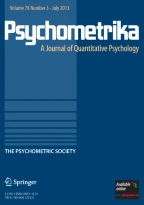Abstract
A solutionT of the least-squares problemAT=B +E, givenA andB so that trace (E′E)= minimum andT′T=I is presented. It is compared with a less general solution of the same problem which was given by Green [5]. The present solution, in contrast to Green's, is applicable to matricesA andB which are of less than full column rank. Some technical suggestions for the numerical computation ofT and an illustrative example are given.
Similar content being viewed by others
References
Bellman, R.Introduction to matrix analysis. New York: McGraw-Hill, 1960.
Dwyer, P. S. and McPhail, M. S. Symbolic matrix derivatives.Ann. math. Statist., 1948,19, 517–534.
Eckart, C. and Young, G. The approximation of one matrix by another of lower rank.Psychometrika, 1936,1, 211–218.
Gibson, W. A. On the least-squares orthogonalization of an oblique transformation.Psychometrika, 1962,27, 193–196.
Green, B. F. The orthogonal approximation of an oblique structure in factor analysis.Psychometrika, 1952,17, 429–440.
HOW. FORTRAN Subroutine, using non-iterative methods of Householder, Ortega, and Wilkinson, solves for eigenvalues and corresponding eigenvectors of a real symmetric matrix. Program writeup F2 BC HOW. Berkeley Division, Univ. Calif., 1962.
Hunter, J. Personal communication, 1964.
Hurley, J. R. and Cattell, R. B. Producing direct rotation to test a hypothesized factor structure.Behav. Sci., 1962,7, 258–262.
Johnson, R. M. On a theorem by Eckart and Young.Psychometrika, 1963,28, 259–263.
Johnson, R. M. The minimal transformation to orthonormality. Paper read at the joint meeting of the Psychonomic Society and the Psychometric Society, Niagara Falls, Ontario, Canada, 1964.
Mosier, C. I. Determining a simple structure when loadings for certain tests are known.Psychometrika, 1939,4, 149–162.
Schmid, J. and Leiman, J. M. The development of hierarchical factor solutions.Psychometrika, 1957,22, 53–61.
Schönemann, P. H., Bock, R. D., and Tucker, L. R. Some notes on a theorem by Eckart and Young. Univ. of North Carolina Psychometric Laboratory Research Memorandum No. 25, 1965.
Thurstone, L. L.Multiple-factor analysis. Chicago: Univ. Chicago Press, 1947.
Tucker, L. R. Personal communication, 1964.
Author information
Authors and Affiliations
Additional information
This paper is based on parts of a thesis submitted to the Graduate College of the University of Illinois in partial fulfillment of the requirements for a Ph.D. degree in Psychology.
The work reported here was carried out while the author was employed by the Statistical Service Unit Research, U. of Illinois. It is a pleasure to express my appreciation to Prof. K. W. Dickman, director of this unit, for his continuous support and encouragement in this and other work. I also gratefully acknowledge my debt to Prof. L. Humphreys for suggesting the problem and to Prof. L. R. Tucker, who derived (1.7) and (1.8) in summation notation, suggested an iterative solution (not reported here) and who provided generous help and direction at all stages of the project.
Rights and permissions
About this article
Cite this article
Schönemann, P.H. A generalized solution of the orthogonal procrustes problem. Psychometrika 31, 1–10 (1966). https://doi.org/10.1007/BF02289451
Received:
Revised:
Issue Date:
DOI: https://doi.org/10.1007/BF02289451
